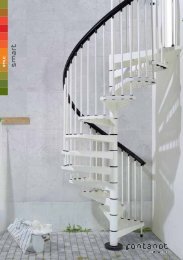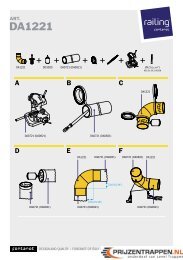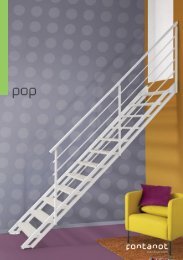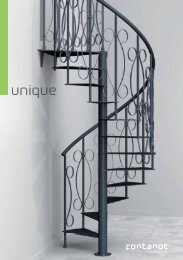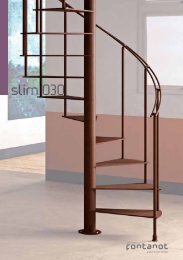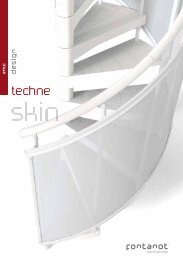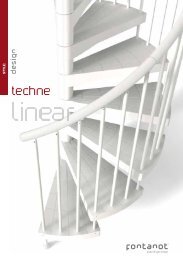Istruzioni_Zooom_ZooomPLUS
Handleiding Zooom PLUS
Handleiding Zooom PLUS
You also want an ePaper? Increase the reach of your titles
YUMPU automatically turns print PDFs into web optimized ePapers that Google loves.
zooom plus<br />
zooom
1.<br />
2.<br />
zooom plus - zooom<br />
2
3.<br />
4. 5.<br />
<strong>Zooom</strong><br />
<strong>Zooom</strong> Plus<br />
3<br />
zooom plus - zooom
SOLO PER/ONLY FOR/NUR FÜR/SEULEMENT POUR/SOLO PARA: ZOOOM PLUS<br />
6.<br />
6.2<br />
6.1<br />
6.3<br />
6.4<br />
6.6<br />
6.5<br />
6.7<br />
7.<br />
zooom plus<br />
4
IT<br />
1. Aprire l’imballo e lasciare al piano inferiore la scala<br />
e il bastone d’apertura, portando al piano superiore le 4<br />
staffe di fissaggio con relativi dadi M10.<br />
2. Aiutandosi con supporti o corde, infilare, da sotto,<br />
la scala nel foro, quindi inserire subito verticalmente le<br />
4 staffe forate sopra le barre filettate M10 sporgenti,<br />
avvitando i dadi M10 con chiave 17mm, fino quando la<br />
battuta inferiore della scala aderisce alla soletta (non<br />
stringere definitivamente).<br />
3. Guardare da sotto la scala (chiusa) e assicurarsi<br />
che la fessura fra telaio e pannello sia costante (scala<br />
in squadro), e comunque che il pannello non tocchi il<br />
telaio. In caso contrario occorre adattare la scala da<br />
sopra, effettuando piccoli spostamenti. Stringere poi<br />
definitivamente la scala a soletta tramite chiave 17mm<br />
ai dadi M10 delle staffe.<br />
N.B. Si consiglia di tagliare la parte di barra filettata<br />
eccedente da dado di bloccaggio.<br />
4. Aprire la scala, da sotto, agendo sull’anello della<br />
serratura tramite il bastone con gancio d’apertura<br />
dopo averlo innestato (è in 2 pz.), ruotare e stendere la<br />
rampa fino a terra (le 2 ruotine piccole in nylon devono<br />
appoggiare a pavimento). Nel caso che la scala debba<br />
essere regolata per altezze al limite del consentito,<br />
occorre agire sui tiranti, avvitando o svitando entrambi i<br />
dadi M10, tramite chiave 17mm (i dadi devono sempre<br />
appoggiare contemporaneamente sui nottolini).<br />
A scala appoggiata, svitare o avvitare il fermo corsa in<br />
modo che lo stesso appoggi sempre sul telaio.<br />
N.B. La scala non va murata.<br />
N.B. Salire e scendere dalla scala sempre con il corpo<br />
rivolto verso la scala.<br />
5. Per l’eventuale montaggio del corrimano, destra<br />
salendo, occorre agire a scala aperta. Posizionare<br />
il corrimano di fianco alla scala, con la leva a “L” in<br />
corrispondenza della leva preforata inferiore, e quella<br />
retta in corrispondenza della leva preforata superiore,<br />
quindi avvitare le 2+2 viti con dadi, tramite cacciavite<br />
e chiave 10mm.<br />
Solo per <strong>Zooom</strong> Plus:<br />
6. Inserire la spina, al piano superiore, sinistra salendo,<br />
a una presa di corrente 220 v. Premere il tasto superiore<br />
del telecomando una sola volta, si noterà l’accensione<br />
del lampeggiante senza movimento della scala; la<br />
centralina sta memorizzando alcuni dati, lasciare<br />
terminare il ciclo. Premere di nuovo lo stesso tasto e<br />
si noterà l’apertura completa della scala. I braccetti di<br />
rotazione rampa appoggeranno sui bulloni M10 di fine<br />
5<br />
corsa. Per chiudere premere di nuovo lo stesso tasto.<br />
Per arrestare il movimento della scala prima della fine<br />
della corsa, basta premere il pulsante del telecomando;<br />
un nuovo impulso rimetterà in funzione la scala, ma<br />
imprimendole un movimento contrario al precedente.<br />
6.1 = Tasto nullo<br />
6.2 = Tasto di manovra<br />
6.3 = Centralina<br />
6.4 = Lampeggiante<br />
6.5 = Braccetto rotazione<br />
6.6 = Motore<br />
6.7 = Bulloni M10 di fine corsa<br />
7. Nel caso si avesse l’assoluta necessità di aprire<br />
la scala in mancanza di elettricità, si dovrà agire nel<br />
seguente modo:<br />
- staccare le 2 parti del bastone;<br />
- tramite il tratto di bastone con forcella, tirare la sfera<br />
con cavo acciaio, situata sotto il pannello e collegata<br />
al meccanismo di sblocco motore;<br />
- mantenendo trazione costante al cavo, tirare fino a<br />
completa apertura pannello;<br />
- mantenendo ancora trazione al cavo, tramite il tratto di<br />
bastone con gancio, agganciare un gradino e stendere<br />
la rampa fino a terra.<br />
N.B. Salire e scendere dalla scala sempre con il corpo<br />
rivolto verso la scala.<br />
EN<br />
1. Open the package and leave on the access floor the<br />
ladder and the pole used to pull down the ladder. Take<br />
the 4 top-fixing brackets with their relevant M10 nuts to<br />
the landing floor.<br />
2. By means of supports and ropes, slip the ladder<br />
inside the aperture from underneath. Immediately after<br />
that, insert the 4 drilled brackets vertically into the M10<br />
threaded projecting bars. Screw down the M10 nuts with<br />
a 17mm ( 43 / 64 ”) wrench, until the bottom frame beam<br />
of the ladder fits snugly to the slab (do not tighten it<br />
completely).<br />
3. Check the ladder (in its stowed position) from<br />
underneath and make sure there is a constant distance<br />
between the frame and the panel (ladder at right angles)<br />
and that, in any case, the panel is not in contact with the<br />
frame. If this is not the case, adjust the ladder from the<br />
top by means of small repositioning movements. Then,<br />
lastly, tighten the ladder firmly to the slab with the M10<br />
nuts by means of the 17mm ( 43 / 64 ”) wrench.<br />
N.B. It is recommended that you cut off the excess<br />
threaded rod from the lock nut.<br />
4. Use the pole that ends with a hook (the pole is made<br />
zooom plus - zooom
up of two sections) to open the ladder from underneath,<br />
by inserting the hook into the projecting ring of the panel<br />
and pull the pole. Then turn and extend the ladder until<br />
it reaches the floor (securely foot the ladder with the<br />
two nylon casters resting firmly on the floor). Should you<br />
need to adjust the ladder for heights falling outside the<br />
standard, you must adjust the rods by either screwing<br />
or unscrewing both M10 nuts with the 17mm ( 25 / 64 ”)<br />
wrench (the nuts must always rest simultaneously on<br />
the ratchets).<br />
While the ladder rests on the floor, screw or unscrew the<br />
end stroke so it always rests on the frame.<br />
N.B. The ladder must not be walled in.<br />
N.B. Climbing up and down the ladder must always take<br />
place with the body facing the ladder.<br />
5. In case you have to assemble a handrail on the right<br />
hand side (facing the ladder), fit it when the ladder is<br />
unfolded. Place the handrail next to the ladder, with the<br />
“L” shaped lever next to the bottom pre-drilled lever<br />
and the “straight” lever next to the top pre- drilled lever.<br />
Next, tighten the 2+2 screws with nuts by means of a<br />
screwdriver and a 10mm ( 43 / 64 ”) wrench.<br />
Only for <strong>Zooom</strong> Plus:<br />
6. On the landing floor, left-hand side while climbing up,<br />
connect the ladder to a 220V power socket. Press the<br />
top button of the remote control once, you will note that<br />
the blinker turns on with no movement of the ladder; the<br />
control unit is memorizing data. Allow it to end its cycle.<br />
Press the same button again and you will notice that the<br />
ladder opens completely. The rotation brackets of the<br />
ladder will rest on the M10 end stroke nuts. To close<br />
the ladder, press the same button again. To stop the<br />
ladders movement before it ends it motion, simply press<br />
the button on the remote control; a new impulse will get<br />
the ladder moving again, but in the opposite direction.<br />
6.1 = Reset button<br />
6.2 = Working button<br />
6.3 = Control unit<br />
6.4 = Blinker<br />
6.5 = Rotating arm<br />
6.6 = Motor<br />
6.7 = M10 Bolt - end stroke<br />
7. In case of lack of electricity, follow the instructions<br />
below:<br />
- divide the two parts of the pole;<br />
- using the forked part of the pole, pull the steel sphere<br />
with the steel cable situated under the panel and<br />
connected to the motor release mechanism;<br />
- keeping the wire taut, pull until the panel is completely<br />
open;<br />
- still keeping the wire taut, use the hooked part of the<br />
pole to pull down on the tread and unfold the ladder to<br />
the floor.<br />
zooom plus - zooom<br />
6<br />
N.B. Climbing up and down the ladder must always take<br />
place with the body facing the ladder.<br />
DE<br />
1. Öffnen Sie die Verpackung und lassen Sie die Treppe<br />
und den Öffnungsstab auf der unteren Etage.<br />
Bringen Sie die 4 Befestigungsbügel mit den zugehörigen<br />
Muttern zu M10 auf die obere Etage.<br />
2. Schieben Sie die Treppe mit Hilfe von Stützen oder<br />
Seilen von unten in die Bodenöffnung und bringen Sie<br />
dann sofort die 4 gebohrten Bügel senkrecht über den<br />
herausragenden Gewindestäben zu M10 an.<br />
Ziehen Sie die Muttern zu M10 mit einem 17mm-er<br />
Schlüssel fest, bis der untere Anschlag der Treppe<br />
auf dem Deckenausschnitt aufliegt (nicht endgültig<br />
festziehen).<br />
3. Schauen Sie die Treppe (geschlossen) von unten<br />
an und vergewissern Sie sich, dass der Schlitz<br />
zwischen Rahmen und Platte konstant ist (Treppe<br />
rechtwinklig) sowie dass die Platte nicht den Rahmen<br />
berührt. Anderenfalls muss die Position der Treppe<br />
von oben durch Vornahme kleiner Verschiebungen<br />
korrigiert werden. Ziehen Sie dann die Treppe am<br />
Deckenausschnitt mit einem 17mm-er Schlüssel an den<br />
Muttern M10 der Bügel fest.<br />
Anm.: Es wird geraten, den aus der Stellmutter<br />
herausragenden Teil des Gewindestabs abzuschneiden.<br />
4. Öffnen Sie die Treppe von unten durch Betätigen des<br />
Rings am Verschluss mit der Stange, die über einen<br />
Haken zum Öffnen verfügt, indem dieser eingeführt<br />
und gedreht wird (besteht aus 2 Teilen). Ziehen Sie die<br />
Treppe bis zum Boden (die beiden kleinen Nylonräder<br />
müssen auf dem Fußboden aufliegen). Sollte die Treppe<br />
wegen Höhen an der Grenze des Zulässigen eingestellt<br />
werden müssen, sind die Zuganker zu betätigen oder<br />
müssen beide Muttern M10 mit 17mm-er Schlüssel<br />
gelöst werden (die Muttern müssen immer gleichzeitig<br />
auf den Klinken aufliegen). Drehen Sie bei aufliegender<br />
Treppe den Zapfen M10x50 ab oder ein, so dass dieser<br />
immer auf dem Rahmen aufliegt.<br />
Bei am Boden angelehnter Treppe, den Endanschlag einoder<br />
abschrauben, sodass er immer auf dem Rahmen<br />
bleibt.<br />
Anm.: Die Treppe darf nicht eingemauert werden.<br />
Anm.: Das Heben und Senken der Treppe muss immer<br />
bei in die gleiche Richtung gedrehtem Körper erfolgen.<br />
5. Für die eventuelle Montage des Handlaufs auf der<br />
rechten Seite beim Hochsteigen muss bei geöffneter<br />
Treppe gearbeitet werden. Positionieren Sie den<br />
Handlauf seitlich der Treppe, so dass sich der “L”-<br />
förmige Hebel am unteren gelochten Hebel und der
Geraden des oberen durchlochten Hebels befindet.<br />
Ziehen Sie dann die 2+2 Schrauben mit Muttern mit<br />
einem Schraubendreher und 10mm-er Schlüssel fest.<br />
Nur für <strong>Zooom</strong> Plus:<br />
6. 220 V ein. Betätigen Sie die obere Taste der<br />
Fernsteuerung einmal. Es ist das Einschalten der<br />
Blinkleuchte ohne Bewegung der Treppe zu erkennen.<br />
Das Steuergerät speichert einige Daten. Lassen Sie es<br />
diesen Zyklus beenden. Betätigen Sie erneut die gleiche<br />
Taste und es ist das vollständige Öffnen der Treppe<br />
erkennbar. Die Arme zur Rotation der Rampe liegen auf<br />
den Bolzen M10 für den Endanschlag auf. Betätigen Sie<br />
zum Schließen erneut die gleiche Taste. Zum Stoppen<br />
der Bewegung der Treppe vor dem Endanschlag genügt<br />
es, die Taste der Fernsteuerung zu betätigen. Ein neuer<br />
Impuls setzt die Treppe wieder in Bewegung, verleiht ihr<br />
aber eine Bewegung entgegengesetzt zur vorherigen.<br />
6.1 = Taste null<br />
6.2 = Steuertaste<br />
6.3 = Steuergerät<br />
6.4 = Blinkleuchte<br />
6.5 = Rotationsarm<br />
6.6 = Motor<br />
6.7 = Bolzen M10 des Endanschlags<br />
7. Sollte es unbedingt notwendig sein, die Treppe bei<br />
Stromausfall zu öffnen, muss wie folgt vorgegangen<br />
werden:<br />
- Trennen Sie die 2 Teile des Stabs;<br />
- Ziehen Sie mit dem Gabelstück des Stabs an der Kugel<br />
mit dem Stahlseil unter der Platte, die mit dem<br />
Mechanismus zur Freigabe des Motors verbunden ist;<br />
- Halten Sie den Zug am Kabel konstant, ziehen Sie, bis<br />
sich die Platte vollständig öffnet;<br />
- Halten Sie den Zug am Kabel mit dem Stababschnitt<br />
mit Haken weiter aufrecht, haken Sie ihn in eine Stufe<br />
ein und fahren Sie die Treppe bis zum Fußboden aus.<br />
Anm.: Das Heben und Senken der Treppe muss immer<br />
bei in die gleiche Richtung gedrehtem Körper erfolgen.<br />
FR<br />
1. Ouvrir l’emballage et laisser dans la pièce inférieure<br />
l’escalier et la perche de manœuvre. Apporter les 4<br />
étriers de fixation à l’étage, avec leurs relatifs écrous<br />
M10.<br />
2. À l’aide de supports et de cordes faire glisser par le<br />
bas l’escalier dans la trémie.<br />
Après ça il faut introduire à la verticale dans les barres<br />
filetées et en saillie M10 les 4 étriers percés. Visser<br />
les écrous M10 avec une clé 17mm jusqu’à ce que le<br />
rebord du caisson s’encastre parfaitement au sousplafond<br />
(il ne faut pas le serrer de façon définitive).<br />
3. Regarder du bas l’escalier (dans sa position repliée<br />
7<br />
ou fermée) et s’assurer que la fissure entre le châssis<br />
et le panneau est constante (escalier à angles droits) et<br />
que de toute façon le panneau ne touche pas le châssis.<br />
Dans le cas contraire, il faut adapter l’escalier par le<br />
haut, en effectuant de petits déplacements.<br />
Enfin, à l’aide de la clé 17mm il faut fixer de façon<br />
définitive l’escalier sur la dalle aux écrous M10 des<br />
étriers.<br />
N.B. Il est recommandé de couper la tige filetée dépassant<br />
de l’écrou de blocage.<br />
4. À l’aide de la perche de manœuvre (qui se compose<br />
de deux sections), déployer l’escalier par le bas en<br />
introduisant le crochet de manœuvre dans l’anneau en<br />
saillie du loquet. Ensuite, tourner et déployer la rampe<br />
jusqu’au sol. (Les deux roulettes en nylon doivent être<br />
au sol). Au cas où il faudrait adapter l’escalier pour des<br />
hauteurs à la limite de ce qui est permis, il faut ajuster<br />
les tirantes/adapter, en vissant ou dévissant les deux<br />
écrous M10 à l’aide de la clé 17mm (les écrous doivent<br />
s’appuyer simultanément sur les ergots de fixation).<br />
Une fois que l’escalier est en appuis, dévisser ou visser<br />
le boulon de fin de course de façon à ce que celui-ci<br />
reste toujours sur le châssis.<br />
N.B. L’escalier ne doit pas être muré.<br />
N.B. Montée et descente sont effectuées avec le corps<br />
faisant face vers l’escalier.<br />
5. Si vous devez monter la main courante, qui sera sur<br />
votre droite en gravissant l’escalier, montez-la lorsque<br />
l’escalier est déployé.<br />
Positionnez la main courante à coté de la rampe ; le<br />
levier en “L” doit être à la hauteur du levier pré-percé<br />
inferieur, du levier pré-percé supérieur.<br />
A ce moment-là serrez les 2+2 vis avec des écrous à<br />
l’aide de tournevis et de la clé 10mm.<br />
Seulement pour <strong>Zooom</strong> Plus :<br />
6. À l’étage, sur le coté gauche en gravissant l’escalier,<br />
enforcer la fiche dans une prise de courant à 220V.<br />
Appuyer sur la touche supérieure de la télécommande<br />
une seule fois : le voyant clignotant s’allumera, mais la<br />
rampe ne bougera pas.<br />
L’unité de commande est en train de mémoriser<br />
quelques données : patient jusqu’à ce cycle d’achève.<br />
Presser à nouveau la même touche : la rampe s’ouvrira<br />
complètement. Les bras de rotation de la rampe seront<br />
appuyés sur les boulons m10 de fin de course. Pour<br />
replier l’escalier, appuyez encore une fois sur le même<br />
touche.<br />
6.1 = Bouton null<br />
6.2 = Bouton de manœuvre<br />
6.3 = Unité eletrique<br />
6.4 = Flashing<br />
6.5 = Rotation du bras<br />
zooom plus - zooom
6.6 = Moteur<br />
6.7 = Boulons M10<br />
7. S’il faut impérativement déployer l’escalier en cas de<br />
panne de courant, on devra suivre les étapes ci-dessous :<br />
- Détacher les deux sections de la perche ;<br />
- A l’aide de la section de la perche à crochet ou fourche<br />
tirer la sphère qui se situe au mécanisme de<br />
déblocage du moteur;<br />
- En maintenant une traction constante, tirer le câble<br />
jusqu’à l’ouverture complète du panneau;<br />
- En maintenant encore la traction au câble, avec le<br />
crochet de la perche de manœuvre tirer une marche et<br />
déployer la rampe jusqu’au sol.<br />
N.B. Montée et descente sont effectuées avec le corps<br />
faisant face vers l’escalier<br />
ES<br />
1. Abrir el embalaje y dejar en el piso inferior la escalera<br />
y el bastón de apertura, llevando al piso superior los 4<br />
soportes de fijación con las respectivas tuercas M10.<br />
2. Ayudándose con soportes o cuerdas, introducir desde<br />
abajo la escalera en el hueco e instalar de inmediato<br />
verticalmente los 4 soportes perforados sobre las<br />
barras roscadas M10 sobresalientes, enroscando las<br />
tuercas M10 con llave 17mm ( 43 / 64 ”), hasta obtener<br />
que la parte delantera de la escalera quede adherida a<br />
la losa (no apretar definitivamente).<br />
3. Mirar la escalera (cerrada) desde abajo y controlar<br />
que la ranura entre bastidor y panel sea constante<br />
(escalera escuadrada) y que, de cualquier forma,<br />
el panel no toque el bastidor. En caso contrario se<br />
debe adaptar la escalera desde arriba, efectuando<br />
pequeños desplazamientos. A continuación, apretar<br />
definitivamente la escalera a la losa mediante llave<br />
17mm ( 43 / 64 ”) con las tuercas M10 de los soportes.<br />
N.B. Se aconseja cortar la parte de barra roscada<br />
excedente respecto de la tuerca de fijación.<br />
4. Abrir la escalera desde abajo operando en el anillo<br />
de la cerradura mediante el bastón con gancho de<br />
apertura después de haberlo acoplado (consta de dos<br />
piezas); girar y extender la rampa hasta el suelo (las<br />
dos ruedas pequeñas de nylon deben quedar apoyadas<br />
en el pavimento).<br />
En caso de que la escalera deba ser regulada para<br />
alturas al límite de lo permitido, se debe operar con los<br />
tirantes, enroscando o desenroscando mediante llave<br />
de 17mm ( 43 / 64 ”) ambas tuercas M10 (ambas tuercas<br />
deben estar siempre apoyadas de modo simultáneo<br />
sobre los pestillos).<br />
N.B. La escalera no debe ser empotrada en el muro.<br />
N.B. La subida y la bajada de la escalera deben<br />
efectuarse con el cuerpo dispuesto siempre en la misma<br />
dirección.<br />
5. Para el eventual montaje del pasamanos, a la<br />
derecha subiendo, se debe operar con escalera abierta.<br />
Posicionar el pasamanos al lado de la rampa con la<br />
palanca en “L” en correspondencia con la palanca<br />
preperforada inferior y aquella recta en correspondencia<br />
con la palanca preperforada superior y enroscar los 2 +<br />
2 tornillos con tuercas mediante destornillador y llave<br />
de 10mm ( 43 / 64 ”).<br />
Solo para <strong>Zooom</strong> Plus:<br />
6. Conectar el enchufe en el piso superior, a la izquierda<br />
subiendo, a una toma de corriente de 220 V. Presionar<br />
el botón superior del telemando una sola vez; se notará<br />
el encendido de la luz intermitente sin movimiento de la<br />
rampa; la centralita está memorizando algunos datos;<br />
esperar que se concluya el ciclo.<br />
Presionar nuevamente el mismo botón y se observará la<br />
apertura completa de la rampa. Los bracitos de rotación<br />
rampa se apoyarán sobre los pernos M10 de final de<br />
carrera. Para cerrar, presionar una vez más el mismo<br />
botón.<br />
Para interrumpir el movimiento de la escalera antes<br />
del final de carrera basta presionar el botón del mando<br />
a distancia; presionando nuevamente el botón se<br />
reanudará el funcionamiento de la escala, pero con<br />
movimiento en sentido opuesto al precedente.<br />
6.1 = Botón nulo<br />
6.2 = Botón de maniobra<br />
6.3 = Centralita<br />
6.4 = Luz intermitente<br />
6.5 = Bracito rotación<br />
6.6 = Motor<br />
6.7 = Pernos M10 de final de carrera<br />
7. En caso de tener absoluta necesidad de abrir la<br />
escalera en ausencia de energía eléctrica, se deberá<br />
proceder de la siguiente forma:<br />
- Separar las 2 partes del bastón.<br />
- Mediante el tramo de bastón con horquilla tirar la<br />
esfera con cable de acero situada debajo del panel y<br />
conectada al mecanismo de desbloqueo motor.<br />
- Manteniendo el cable en tracción constante, tirar<br />
hasta obtener la completa apertura del panel.<br />
- Manteniendo aún en tracción el cable, usar el tramo<br />
de bastón con gancho para enganchar un peldaño y<br />
extender la rampa hasta el suelo.<br />
N.B. La subida y la bajada de la escalera deben<br />
efectuarse con el cuerpo dispuesto siempre en la misma<br />
dirección.<br />
Apoyada la escalera, enroscar o desenroscar el perno<br />
de final de carrera de manera que sea siempre sobre<br />
el bastidor.<br />
zooom plus - zooom<br />
8
Italiano<br />
English<br />
Deutsch<br />
Français<br />
Español<br />
DATI IDENTIFICATIVI DEL PRODOTTO<br />
PRODUCT DETAILS<br />
PRODUKTEIGENSCHAFTEN<br />
DONNÉES D’IDENTIFICATION DU PRODUIT<br />
DATOS DE IDENTIFICACIÓN
zooom plus - zooom<br />
10
IT)<br />
dati identificativi del prodotto<br />
denominazione commerciale: ZOOOM PLUS<br />
tipologia: scala retrattile motorizzata a pantografo<br />
materiali impiegati<br />
GRADINI E LEVE<br />
materiali<br />
alluminio pressofuso<br />
finitura<br />
verniciatura a polvere poliestere bianco<br />
CASSONETTO<br />
materiali<br />
lamiera d’acciaio spessore 1,2 mm<br />
finitura<br />
verniciatura a polvere poliestere bianco<br />
PULIZIA E MANUTENZIONE OBBLIGATORIA<br />
Eseguire la pulizia della scala alla prima comparsa di<br />
macchie di sporco e depositi di polvere e periodicamente<br />
almeno ogni 6 mesi con panno morbido inumidito in acqua<br />
e detergenti specifici non abrasivi ed aggressivi. NON<br />
usare mai pagliette abrasive o in ferro. Pulire ed asciugare<br />
accuratamente dopo il lavaggio con un panno in microfibra<br />
al fine di eliminare gli aloni del calcare presente nell’acqua.<br />
Al verificarsi di qualsiasi minimo malfunzionamento è<br />
obbligatorio effettuare una manutenzione straordinaria, da<br />
eseguire subito e a regola d’arte.<br />
PRECAUZIONI D’USO<br />
Non esporre la scala a materiali/agenti corrosivi.<br />
Non installare la scala in ambienti umidi. Periodicamente<br />
controllare lo stato della scala e oliare le giunture.<br />
Non installare la scala per altezze inadeguate.<br />
PANNELLO<br />
materiali<br />
pannello in multistrato di pioppo di prima scelta<br />
grezzo, spessore 14 mm, a bassissima emissione<br />
di formaldeide (certificato classe E1 norma UNI EN<br />
13986:2005). Pannello completamente rivestito con<br />
materiale isolante sia termico che acustico<br />
materiali<br />
moquette nera<br />
PEDATE<br />
dati identificativi del prodotto<br />
denominazione commerciale: ZOOOM<br />
tipologia: scala retrattile a pantografo<br />
materiali impiegati<br />
GRADINI E LEVE<br />
materiali<br />
acciaio stampato<br />
finitura<br />
zincatura trivalente cromo III<br />
CASSONETTO<br />
materiali<br />
acciaio stampato<br />
finitura<br />
verniciatura a polvere poliestere bianco<br />
PANNELLO<br />
materiali<br />
pannello in truciolare di pioppo, spessore 16 mm, a<br />
bassissima emissione di formaldeide (certificato classe<br />
E1 norma UNI EN 13986:2005).<br />
11<br />
zooom plus - zooom
EN)<br />
product details<br />
trade name: ZOOOM PLUS<br />
type: electric scissor loft ladder<br />
used materials<br />
LEVERS AND TREADS<br />
materials<br />
die-cast aluminium<br />
finishing<br />
oven painted polyester embossed white powder<br />
HATCH FRAME<br />
materials<br />
1,2 mm ( 3 / 64 ”)-thick sheet-steel<br />
finishing<br />
oven painted polyester embossed white powder<br />
OBLIGATORY CLEANING AND MAINTENANCE<br />
Clean the treads as soon as dirt spots and dust deposits<br />
appear and at least every 6 months using a soft cloth<br />
moistened with water and specific non-abrasive and nonaggressive<br />
detergents. NEVER use abrasive scourers. After<br />
cleaning, thoroughly dry the surfaces with a microfibre cloth<br />
to remove the haloes that form because of the limestone<br />
in the water. Should even the smallest malfunction occur,<br />
it is obligatory to immediately and professionally carry out<br />
extraordinary maintenance.<br />
USE PRECAUTION<br />
Do not expose the ladder to corrosive substances.<br />
Do not install the ladder in wet environment. From time to<br />
time check the ladder’s condition and oil the joints.<br />
Do not install the ladder for inappropriate heights.<br />
PANEL<br />
materials<br />
14 mm ( 35 / 64 ”)-thick first choice poplar plywood trap<br />
door, with very low formaldehyde emissions (Class<br />
E1 certified, to Standard UNI EN 13986:2005). Panel<br />
always covered with a high performing isolation material<br />
materials<br />
black carpet<br />
TREADS<br />
product details<br />
trade name: ZOOOM<br />
type: scissor loft ladder<br />
used materials<br />
LEVERS AND STEPS<br />
materials<br />
pressed steel<br />
finishing<br />
high strength galvanisation “Trivalent Chrome”<br />
HATCH FRAME<br />
materials<br />
pressed steel<br />
finishing<br />
oven painted polyester embossed white powder<br />
PANEL<br />
materials<br />
16 mm ( 5 / 8 ”)-thick first choice poplar plywood, with very<br />
low formaldehyde emissions (Class E1 standard UNI EN<br />
13986:2005)<br />
zooom plus - zooom<br />
12
DE)<br />
Produkteigenschaften<br />
kommerzielle Bezeichnung: ZOOOM PLUS<br />
Typologie: elektrisch einziehbare Scherentreppe<br />
verwendete Materialien<br />
STUFEN UND HEBEL<br />
Materialen<br />
Aluminiumdruckgruss<br />
Ausführung<br />
Lackpolyester-Lackierung weiss<br />
REINIGUNG UND VORGESCHRIEBENE INSTANDHALTUNG<br />
Die Treppe sofort reinigen wenn Schmutzfl ecken und<br />
Staubansammlungen entstehen und sie mindestens<br />
alle 6 Monate mit einem weichen, mit Wasser und einem<br />
spezifischen, weder scheuernden, noch aggressiven<br />
Reinigungsmittel befeuchteten Lappen abzuwischen.<br />
NIEMALS scheuernde Eisenschwämme verwenden. Nach<br />
der Feuchtreinigung mit einem Mikrofasertuch sorgfältig<br />
nachtrocknen, um die Schlierenbildung durch kalkhaltiges<br />
Wasser zu vermeiden. Bei Auftreten einer noch so geringen<br />
Funktionsstörung muss unbedingt sofort eine fachgerechte<br />
außerordentliche Instandhaltung durchgeführt werden.<br />
KASTENRAHMEN<br />
Materialen<br />
1,2 mm dickes Stahlblech<br />
Ausführung<br />
Lackpolyester-Lackierung weiss<br />
LUKENDECKEL<br />
Materialen<br />
Lukendeckel aus hochwertiger mehrlagiger Spanplatte<br />
(14 mm dick, zertifizierte sehr niedrige Formaldehyd-<br />
Emission, Klasse E1 Norm UNI EN 13986:2005).<br />
Lukendeckel komplett mit thermischem und<br />
akustischem lsoliermaterial beschichtet<br />
TRITTSTUFEN<br />
Materialen<br />
schwarzer Teppichboden<br />
VORSICHTSMASSNAHMEN FÜR DIE ANWENDUNG<br />
Setzen Sie die Leiter keinen ätzenden Materialien/<br />
Substanzen aus. Stellen Sie die Leiter nicht in feuchten<br />
Bereichen auf. Überprüfen Sie regelmäßig den Zustand der<br />
Leiter und ölen Sie die Verbindungsstellen.<br />
Montieren Sie die Leiter nicht in unangemessenen Höhen.<br />
Produkteigenschaften<br />
kommerzielle Bezeichnung: ZOOOM<br />
Typologie: einziehbare Scherentreppe<br />
verwendete Materialien<br />
STUFEN UND HEBEL<br />
Materialen<br />
gepresster Stahl<br />
Ausführung<br />
verzinkt mit hochresistenter Chrom III Galvanisierung<br />
KASTENRAHMEN<br />
Materialen<br />
gepresster Stahl<br />
Ausführung<br />
verzinkt mit hochresistenter Chrom III Galvanisierung<br />
LUKENDECKEL<br />
Materialen<br />
Lukendeckel aus hochwertiger Spanplatte (16 mm dick<br />
zertifizierte sehr niedrige Formaldehyd-Emission, Klasse<br />
E1 Norm UNI EN 13986:2005)<br />
13<br />
zooom plus - zooom
FR)<br />
données d’identification du produit<br />
denomination commerciale : ZOOOM PLUS<br />
type : escalier rétractable motorisé à pantographe<br />
matériaux utilisés<br />
MARCHES ET LEVIERS<br />
matériaux<br />
aluminium moulé sous pression<br />
finition<br />
peinture à la poudre polyester blanche<br />
CAISSON<br />
matériaux<br />
tôle d’acier de 1,2 mm d’épaisseur<br />
finition<br />
peinture à la poudre polyester blanche<br />
NETTOYAGE ET MAINTENANCE OBLIGATOIRE<br />
Nettoyer les marches dès que des taches de saleté ou des<br />
dépôts de poussière apparaissent ; effectuer également<br />
un nettoyage périodique, tous les 6 mois, à l’aide d’un<br />
chiffon doux, humecté d’eau et de détergents spécifiques<br />
non abrasifs et non agressifs. NE JAMAIS utiliser de la<br />
paille de fer abrasive. Après lavage, nettoyer et essuyer<br />
soigneusement avec un chiffon en microfibre, afin d’éliminer<br />
les auréoles provoquées par le calcaire contenu dans<br />
l’eau À la moindre défaillance, il est obligatoire d’effectuer<br />
immédiatement une maintenance corrective, dans les règles<br />
de l’art.<br />
PRÉCAUTIONS D’EMPLOI<br />
Ne pas exposer l’escalier à des matières/agents corrosifs.<br />
Ne pas installer l’escalier dans un environnement humide.<br />
À intervalles réguliers, contrôler l’état de l’escalier et<br />
lubrifier les jonctions. Ne pas installer l’escalier pour des<br />
hauteurs inadaptées.<br />
PANNEAU<br />
matériaux<br />
panneau en contreplaqué de peuplier de premier<br />
choix brut, épaisseur 14 mm, à très basse émission<br />
de formaldéhyde (certifié classe E1 norme UNI EN<br />
13986:2005). Panneau entièrement revêtu d’un<br />
matériau d’isolation thermique et acoustique<br />
matériaux<br />
moquette noire<br />
GIRONS<br />
données d’identification du produit<br />
denomination commerciale : ZOOOM<br />
type : escalier rétractable à pantographe<br />
matériaux utilisés<br />
MARCHES ET LEVIERS<br />
matériaux<br />
acier moulé<br />
finitura<br />
zingage trivalent chrome III<br />
CAISSON<br />
matériaux<br />
acier moulé<br />
finitura<br />
peinture à la poudre polyester blanche<br />
PANNEAU<br />
matériaux<br />
panneau en aggloméré de peuplier, épaisseur 16 mm, à<br />
très basse émission de formaldéhyde (certifié classe E1<br />
norme UNI EN 13986:2005)<br />
zooom plus - zooom<br />
14
ES)<br />
datos de identificación del producto<br />
denominación comercial: ZOOOM PLUS<br />
tipo: escalera retráctil motorizada de pantógrafo<br />
materiales empleados<br />
PELDAÑOS Y PALANCAS<br />
materiales<br />
aluminio fundido a presión<br />
acabado<br />
pintura en polvo poliéster blanco<br />
CAJÓN<br />
materiales<br />
chapa de acero de 1,2 mm ( 3 / 64 ”) de espesor<br />
acabado<br />
pintura en polvo poliéster blanco<br />
LIMPIEZA Y MANTENIMIENTO OBLIGATORIO<br />
Realizar la limpieza de la escalera en cuanto aparezcan<br />
manchas de suciedad y depósitos de polvo, y periódicamente<br />
al menos cada 6 meses, con un paño suave humedecido en<br />
agua y detergentes específicos no abrasivos ni agresivos.<br />
NO utilizar nunca lanas abrasivas o de hierro. Limpiar y secar<br />
bien después del lavado utilizando un paño de microfibra<br />
para eliminar las aureolas de cal dejadas por el agua. Ante<br />
el menor defecto de funcionamiento, es obligatorio realizar<br />
un mantenimiento extraordinario según las reglas del arte.<br />
PRECAUCIONES DE USO<br />
No exponer la escalera a materiales o agentes corrosivos.<br />
No instalar la escalera en un ambiente húmedo.<br />
Comprobar periódicamente el estado de la escalera y<br />
lubricar con aceite las juntas. No instalar la escalera para<br />
alturas inadecuadas.<br />
PANEL<br />
materiales<br />
panel de madera multicapa de chopo de primera calidad<br />
en bruto, de 14 mm ( 35 / 64 ”) de espesor, con una muy<br />
baja emisión de formaldehído (certificado clase E1<br />
norma UNI EN 13986:2005). Panel completamente<br />
revestido con material aislante, tanto térmico como<br />
acústico<br />
materiales<br />
moqueta negra<br />
HUELLAS<br />
datos de identificación del producto<br />
denominación comercial: ZOOOM<br />
tipo: escalera retráctil de pantógrafo<br />
materiales empleados<br />
PELDAÑOS Y PALANCAS<br />
materiales<br />
acero prensado<br />
acabado<br />
galvanizado trivalente de cromo III<br />
CAJÓN<br />
materiales<br />
acero prensado<br />
acabado<br />
pintura en polvo poliéster blanco<br />
PANEL<br />
materiales<br />
panel de madera conglomerada de chopo, de 16 mm ( 5 / 8 ”)<br />
de espesor, con una muy baja emisión de formaldehído<br />
(certificado clase E1 norma UNI EN 13986:2005)<br />
15<br />
zooom plus - zooom
http://www.fontanot.it<br />
Fontanot S.p.A.<br />
Sede legale ed amministrativa<br />
via P. Paolo Pasolini, 6<br />
47853 Cerasolo Ausa<br />
Rimini, Italy<br />
Design: Centro Ricerche Fontanot<br />
Sistema aziendale Fontanot S.p.A.<br />
certificato CSQ ISO-9001<br />
tel. +39.0541.90.61.11<br />
fax. +39.0541.90.61.24<br />
info@fontanot.it<br />
www.fontanot.it



